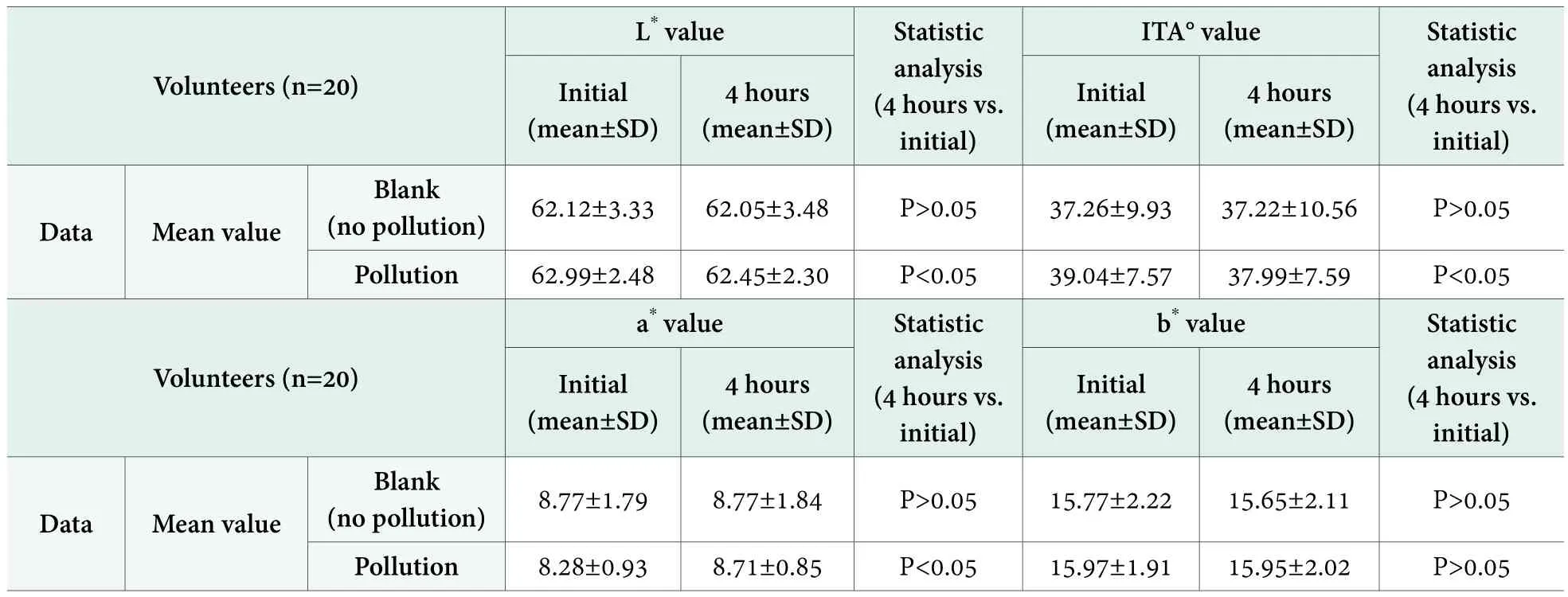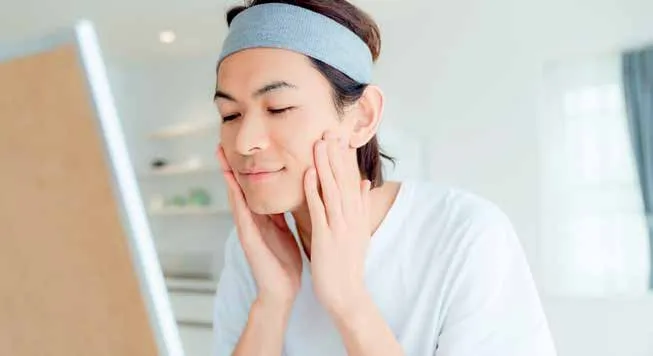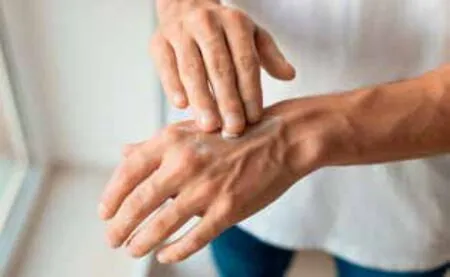Multiple Effects of Air Pollution on Chinese Male Skin
2018-02-20WangZhengGuoYiguangQiaoXiaoling
Wang Zheng, Guo Yiguang, Qiao Xiaoling
Shanghai Jahwa United Co., Ltd., China
Abstract Air pollution is becoming a very important subject, especially in big cities. In the past years, many publications reported potential adverse effects of air pollution on skin, such as skin in flammation, skin aging and pigmentation. Although men are more often exposed to environment due to probably longer time working,sporting and smoking, the researches about adverse effects of air pollution on male skin are relatively smaller.This article focuses the correlation between air pollution and male skin disorders. We found out that, in the mimic pollution environment for 4 hours, the skin L* value and ITA° value are decreased, a* value is increased,urea content is decreased, keratin carbonylation value is increased. While, water content, transepidermal water loss (TEWL), lactic content and ceramides content remain the same.
Key words air pollution; male skin; cigarettes; skin color; carbonylation; urea content
Introduction
Air pollution is becoming a very important subject,especially in big cities. In the past years, many publications reported potential adverse effects of air pollution on skin.
Previous reports demonstrate that chronic air pollution exposure is associated with premature skin aging, with 20% increase in pigment spots and more pronounced nasolabial fold.[1]In addition, other epidemiological data showed that pollutants may increase the incidence of atopic dermatitis in young people[2]and aggravate their symptoms,[3]particularly the itching sense,[4]and may also be the cause of increased urinary ROS in the children with atopic dermatitis.[5]Several epidemiologic data[3-5]suggest that PM may penetrate the skin barrier to increase ROS, which aggravates skin inflammation. A clinical study performed in Mexico City revealed significant alterations of several skin biochemical and physiological parameters in response to pollution,such as an increased level of sebum excretion rate, a lower level of vitamin E and squalene within sebum, an increase in lactic acid and a higher level of carbonylated proteins.[6]A study performed in Shanghai demonstrated significant differences in several biochemical parameters measured in Chong Ming area, as compared to Urban area, with an increased ratio of squalene/lipids, a lower level of lactic acid and a better cohesion of stratum corneum.[7]
The previous studies usually used epidemiological method to reveal the chronic effects of air pollution on human skin. They usually evaluated the differences of skin biochemical parameters between volunteers in rural area and in urban area with heavier air pollution.[6-7]But it was hard to limit the variables only to the air pollution level between rural and urban environment. The temperature,water content of air, light exposure level may also be different between urban and rural area. In addition, the living habits, sporting time, quality of foods may also be different between volunteers live in rural and urban area.
In this study, we used cigarettes smog in a sealed box to mimic the air pollution environment. Cigarettes smog is one of the most common and well-known indoor air pollution and especially for men. It was reported that the components of cigarettes smog is similar with air pollution, such as carbon monoxide, nitrogen oxides,total particles and polycyclic aromatic hydrocarbons.[8]So this design can ensure the only difference for skin of volunteers is the cigarettes mimic air pollution inside and outside the box.
Men are more often exposed to the environment pollution probably due to longer time working, sporting and smoking. So, air pollution may have more adverse effects on male skin. But the previous studies often focused on the skin of both man and woman. To find out the adverseness of air pollution on male skin, in this paper, we studied the change of several skin parameters of 20 Chinese men using above air pollution mimic design.
Materials and methods
The study included 20 healthy Chinese male volunteers between 20 and 30 years of age, and the left and right forearms of the volunteers were used for the test.The places near wrist on both right and left arms were used to take measurements, while the places near elbow on both right and left arms were used to take samples.
One burned cigarette in a 60cm⋆60cm⋆30cm sealed box was used to mimic environment pollution. The temperature was controlled as 24 ~ 26℃, humidity was controlled as 40% ~ 60%, and the PM2.5 value was controlled at above 200 μg/m³ in the box area. Half of forearms were put into the pollution mimic environment as “pollution” samples, while the other half of forearms were put into the normal atmosphere as “blank” samples.The forearms of volunteers were measured and taken samples right before and 4 hours after putting into the pollution mimic box (PM2.5 > 200 μg/m³).
The water content was measured 5 times at each area by using Corneometer (CM825, Courage and Khazaka,Germany), and the mean value was calculated and used for further analysis. The Transepidermal water loss(TEWL) value was measured 3 times at each area by using Aquaflux (BIOX AF200, Biox system Ltd., UK), and the mean value was calculated and used for further analysis.The skin color was measured 3 times at each area by using Chromameter (CR-400, Konica Minolta, Japan),and the mean value was calculated and used for further analysis. The components values of skin (urea, lactic acid and ceramides content) were measured by using Skin Composition Analyzer which is a Raman confocal microspectrometer. 10 lines were measured in each area and the fingerprint data can be read from interval of 400 ~1,850 cm-1. We used D-squame to take samples from arms of volunteers, and the carbonylation value of keratin was measured by 5-FTSC Fluorescent labeling method.
T test and Dunnett test were taken to do statistical analysis and the level of significance was p<0.05.
Results and discussion
Transepidermal water loss (TEWL)
Table 1 shows the mean value of TEWL of forearms putting outside and inside of pollution mimic box measured by Aquaflux.
Results show that TEWL has no significant difference before and after 4 hours within or without pollution mimic environment. Previous study[7]showed that people lived in urban area have worse stratum corneum quality than people lived in rural area, so air pollution may cause bad skin barrier function. But this study showed that the change of skin barrier function of skin caused by air pollution maybe a chronic process and skin hydration status cannot be changed in a short time as 4 hours.
Water content
Table 2 shows the mean value of water content of forearms putting outside and inside of pollution mimic box measured by Corneometer.

Table 1. TEWL results

Table 2. Water content results
Results show that skin water content has no significant difference before and after 4 hours within or without pollution mimic environment. Previous studies[6,7]showed that people lived in urban area are dryer than people lived in rural area, so air pollution may cause dryer skin. These studies assumed that dryer skin may caused by worse barrier function which is introduced. But this study showed that the change of skin hydration status of skin caused by air pollution maybe a chronic process and skin hydration status cannot be changed in a short time as 4 hours.
Skin color
Table 3 shows the mean value of skin color related results (L*, a*, b*and ITA° value) of forearms putting outside and inside of pollution mimic box measured by Chromameter.
The results show that compared to initial value, L*value and ITA° value are decreased, a*value is significant increased after 4 hours pollution mimic condition. While blank area without pollution has no significant change.
This study showed that male skin color becomes darker under air pollution, which is indicated by the decrease of L*and ITA° value. The skin color was measured immediately after air pollution environment without any treatments, so the skin darkness may be caused by the adhere of cigarette dust. The skin darkness may also caused by the increase of carbonylation level of keratin as reported by I. Iwai et al.[9,10]It is also necessary to note that increase of keratin carboylation level may combined with skin aging as described by Wang Zhihui and Kyung Eun Kima.[13,14]
Air pollution change the skin color to more reddish,possible inflammation occurrence, as implied by the increase of a*value. Previous study showed that skin inflammation may cause the skin flushing, which will increase the a*value.[11]This result is well correlated accord with the observations study from Yang et al.[12]
Urea content
Table 4 shows the mean value of urea content of forearms putting outside and inside of pollution mimic box.
The results show that compared to initial value,the urea content is significant decreased after 4 hours pollution mimic condition; while, urea content in blank area without pollution has no significant change.
As indicators of NMF (natural moisturizing factor),under 4 hours of pollution environment, urea content decreases obviously. NMF including urea is first formed within the corneocytes by degradation of the histidinerich protein known as filaggrin.[15]The decrease of urea content maybe because of that air pollution triggers the filaggrin down-regulation, which is accord with the result of C.W. Lee's study.[16]

Table 3. Skin color related results

Table 4. Urea content results


Table 6. Ceramides content results
Lactic acid content
Table 5 shows the mean value of lactic acid content of forearms putting outside and inside of pollution mimic box.
The results show that compared to initial value, there is no significant change of lactic acid content within or without pollution mimic environment for 4 hours. Lactic acid is a biochemical marker of the cellular oxidative status and the increase of lactic acid can result from a pollutant related oxidative stress.[7]Lefebvre, M.A. found out the higher lactic acid skin content observed in Shanghai and Mexico Urban area.[6,7]But in this study, lactic acid skin content is not changed after 4 hours exposing to air pollution. This result may indicate that the change of lactic acid is a chronic process which needs longer pollution exposing time or reaction time and the skin is able to resist the oxidative stress during a time period by its own sebum components, like squalene and vitamin E.
Ceramides content
Table 6 shows the mean value of ceramides content of forearms putting outside and inside of pollution mimic box.
The results showed that compared to initial value,there is no significant change of ceramides content within or without pollution mimic environment for 4 hours.
Same as the water content and TEWL value, no change of ceramides concentration may because that the short time exposing, in this case 4 hours, may not be long enough to affect the parameters above. This may also because of that male skin has an overall 10~20% thicker than woman,[17]which is more resistant to the air pollution effects in a short time.

Table 7. Keratin carbonylation value results

Measurement time Volunteers (n=20)Blank(no pollution)(4 hours)Pollution(4 hours)Statistic analysis(4 hours vs. initial)Data Keratin carbonylation value(mean ± SD) 33.02±13.53 44.05±13.36 P<0.05

Figure 1. Fluorescent photos of 7# volunteer
Keratin carbonylation value
We use 5-FTSC Fluorescent labeling method to analyze the keratin carbonylation content from the samples taken from forearms of volunteers. The Tape-striping from volunteers were stained by 5-FTSC fluorescent dye (DMSO :2-MES = 1:1000) and examined by a fluorescent microscope.The photos of one sample taken by fluorescent microscope were showed in Figure 1 below.
The fluorescence intensity (IOD) and the area (Area) of photos were analyzed by Image Pro Plus. The carbonylation value was calculated by IOD / Area and Table 7 shows the mean value of keratin carbonylation content of forearms putting outside and inside of pollution mimic box.
The results show that after 4 hours experiments, the carbonylation value in mimic pollution environment is significant higher than in blank environment. This result showed the oxidative damage of air pollution on human skin,which is in line with the previous study in Mexico.[6]
The increase of keratin carboylation level may cause skin darker and skin aging. The change of skin color is testified by L⋆ value decrease presented before. About skin aging,previous study showed that the protein carbonylation is an important index of skin oxidative level, and will affect the protein function and cause skin aging.[13]Another study showed that ROS and pro-inflammatory cytokines caused by pollution can result in increased skin aging.[14]This study come up with that protein carbonylation may be another reason of pollution induced skin aging.
Conclusion
This study used a new lab method to mimic the air pollution environment and found out the effects of air pollution on Chinese male skin. Particularly, air pollution can make skin more reddish, make skin darker, aggravate skin protein carbonylation and decrease skin urea content.
This study also demonstrated that air pollution cannot change some skin factors in short time, 4 hours in this study.In particular, the skin hydration level, TEWL value, lactic acid content was not changed after into 4 hours air pollution.Which may indicate that the effects of air pollution on skin is a chronic process. Nevertheless, further work remains necessary to understand, on a fundamental level, the relation between parameters observed in our study and the indepth functioning of the different skin layers, when exposed to polluted environmental conditions.


杂志排行
China Detergent & Cosmetics的其它文章
- Alibaba's Tmall and L'Oréal China Partner Up to Launch New Campaign for Men's Grooming Products
- Pechoin Wins the Innovation Golden Award at the 30th IFSCC Congress in Munich
- Coming Soon on Tmall: Boots Makes First Move into China
- IFF's New Naturals Lab in China Is the First Outside of the US
- 2018 CCIA Annual Meeting &Industry Convention Successfully Held in Zhuhai
- Major Industry Events
